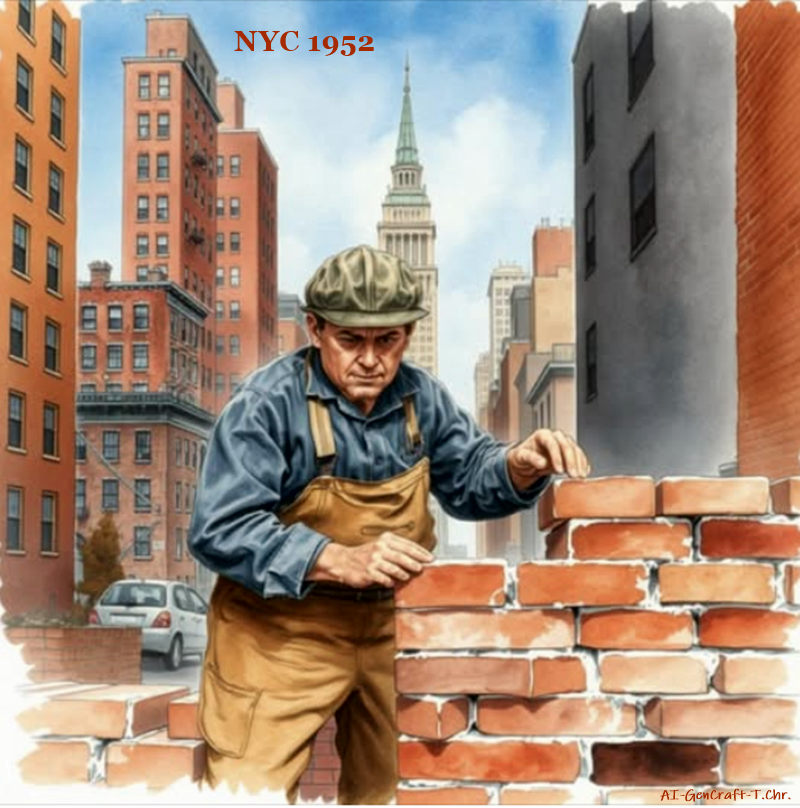THEY DONT BUILD U.S. MEN THE WAY THEY USED TO.

By T.Chr.-Human Synthesis-24 August 2025
They don’t build houses the way they used to. And men—they don’t build lives the way we once did either. I’m seventy-four now, hands stiff as frozen lumber, knees swollen from a lifetime of ladders and scaffolds. My grandkids laugh when they see the old photos—me shirtless in the July sun, mortar smeared across my chest like war paint, a cigarette dangling from my lip while I laid brick faster than most men could count.
Way back when that meant something.
I started at seventeen, mixing mortar for my uncle in ’66. Vietnam was raging, Detroit was burning, but all I cared about was learning the trade. My hands blistered, my back screamed, and my uncle told me, “If you last the first summer, you’ll last a lifetime.” I did. Fifty years of it. Houses, schools, factories—walls that still stand when men are long gone.
I drive past some of those houses now, brick still straight, mortar still holding. Young families park shiny cars in the driveways, kids bounce basketballs against walls I raised in a single day. They don’t know who built them. They don’t need to. That’s the beauty of brick—you don’t remember the mason, you just live inside the strength he left behind.
These days, my mornings are quiet. No foreman barking. No crew swearing over busted pallets. Just me, black coffee cooling too fast, staring out the kitchen window at a neighborhood that used to hum with hammers and saws. Most of the men I knew are dead—cancer, heart attacks, bad livers. The few still breathing walk with canes, eyes glassy with pain meds. We gave our youth to the job and asked for nothing but a cold beer at quitting time.
Don’t mistake me—I’m not bitter. There was a pride in it, a grit that’s missing now. Back then, you judged a man by the calluses on his hands, not the screen time on his phone. A handshake sealed more than a contract. And when a storm came tearing through town, we didn’t wait on the government—we grabbed hammers and fixed each other’s roofs.
I tell my grandkids stories, and they nod politely, half-listening while their thumbs dance across glowing screens. They don’t understand a world where sweat was currency and strength was survival. How could they? They live in houses we built, on roads we paved, in a country we held together with raw knuckles and bent spines.
But here’s the truth I’ve learned: mortar crumbles, backs break, memories fade. What lasts isn’t the walls you raise—it’s the way you stood while raising them. It’s showing up when the rain was sideways, when your hands split open, when the boss said “one more row before lunch.” It’s carrying yourself like a man whose word was worth more than his pay-check.
That’s what I want them to know. Not that I was a bricklayer, but that I never quit on a wall, or on the men beside me. That even now, when my bones groan like old wood, I stand straight in spirit.The good old days? They weren’t easy. They were hard as hell. But they gave us something solid, something this world seems to be running short on: weight in the soul.
And when I’m gone, I don’t need my name carved in stone. Just let me be remembered in the strength of the houses that outlived me, in the quiet dignity of work done right, and in the lesson my grandkids will one day understand: a man is only as lasting as what he builds in others.
The bell above the door jingled, and I stepped into O’Malley’s, the corner bar that smelled of sawdust, beer, and a lifetime of stories. Frank was at the corner table, polishing a hammer, Benny carving a block of oak, and Tommy behind the counter gave me a nod and poured coffee steaming from the pot. Here, in this simple bar, no introductions were needed. We were all men who had built half the town and still carried the scars to prove it.
We ate our lunch slowly, sandwiches wrapped in wax paper, thermoses of coffee passed around. No one checked messages, no one scrolled. We talked about kids, grandchildren, fishing trips, mistakes, triumphs, and old jobs finished in sweat and laughter. A handshake, a pat on the back, a shared joke—contracts and promises were made in those moments, stronger than any paper could hold.
Later, a foreman called us to the Henderson warehouse, roof damaged in last week’s storm. Ladders leaned against brick, scaffolds rattled, mortar mixed with aching backs and blistered palms. By the afternoon, bricks stacked faster than a young crew could follow, old rhythms carrying us forward. These walls weren’t just wood and brick; they were trust, endurance, and pride made visible.
After work, back at O’Malley’s, we lingered over chili and black coffee. Joe told of the time he fell from a scaffold but caught himself on a beam, only to be cheered by the crew rather than scolded. Frank remembered a storm that tore through town, and how we spent the night fixing roofs and chimneys, never asking for thanks. Benny whittled quietly, occasionally adding commentary that made everyone chuckle.
And I thought of New York, where I had once been young and restless, a seaman on Brooklyn docks in the 1950s. Steamships hissing, cargo stacked, men shouting in a dozen languages, hammers clanging on steel. Nights in Little Italy, neon lights reflecting on wet cobblestones, jazz spilling from smoky bars, sailors and laborers laughing over cheap whiskey. I’d walk up 42nd Street, the billboards blazing like daylight at midnight, taxis honking, street vendors shouting, theater doors swinging open with a promise of music and escape. Downtown Manhattan had a different rhythm—ships docking, cranes lifting, men shouting orders over the roar of engines and cables. I’d pause by the waterfront, breathe in salt and smoke, and think, I Love NYC.
I remember one night on 42nd Street, sidewalks slick from rain, neon lights dancing on puddles like liquid color. A street musician played a saxophone so raw it made your chest ache. I dropped a coin into his case, and he winked at me. No words, just a nod. That was enough. Trust and connection in the city didn’t always come from paper or promises—it came from these small moments of recognition, respect, and shared humanity.
Another evening, downtown near the piers, a fight broke out over some cargo dispute. I stepped closer, a young sailor among older dockhands. Nobody threw a punch at me, but everyone watched. A single nod, a quiet word, a firm stance—conflict diffused. That’s how it worked in those streets: respect was earned, not demanded. You kept your word, you backed your mates, and you lived to see another sunrise.
Later, when I went into business—shipping supplies, construction materials—I carried those lessons with me. Whether on NYC docks or a small-town warehouse, honesty built more than profit. People remembered you for your word, your reliability, the way you treated others in quiet acts of integrity.
Now, seventy-four years old, boots dusty, hands stiff, knees aching, I sat in the bar with my old friends, feeling the warmth of decades of labor, loyalty, and laughter. The world outside had changed—steel and glass replaced brick and timber—but inside this small bar, the rhythm of honest work, handshake agreements, and quiet dignity still lived.
When we finally stood, hands gripping the doorframe, a firm nod, a handshake, a silent promise to each other, I felt it: the old ways had not vanished entirely. Outside, the town slept under a blanket of stars and snow, but in every step we took, every wall we built, every friendship kept alive, the world remembered what it meant to be decent, honourable, and strong.
And that, I thought, smiling into the cold night, was enough.
A philosophical overview of the story:
This story is a meditation on time, labor, and human character. At its core, it reflects on what it means to build—not just walls, houses, or businesses—but a life grounded in integrity, effort, and loyalty. The narrator’s journey spans decades, from the hands-on toil of bricklaying to the chaotic vibrancy of New York City docks, and finally to the quiet reflection of later years.
The narrative juxtaposes the solidity of physical labor with the fleeting nature of recognition. Mortar crumbles, bricks shift, and buildings may fall—but the true measure of a man lies in how he stands while building, how he treats those around him, and the values he leaves behind. Work becomes more than a means to survive; it becomes a vessel for trust, character, and intergenerational lessons.
Bars, street corners, piers, and theaters are not just settings—they are arenas where respect, friendship, and ethics are forged. A handshake once carried more weight than any contract; a nod or a simple act of recognition conveyed more truth than a page of words. The story celebrates these human connections, emphasizing that the strength of a community relies on honesty, reliability, and the courage to show up, even in hardship.
Through NYC streets, from 42nd Street’s neon chaos to the quiet dignity of small-town bars, the story conveys the universality of effort, struggle, and human bonds. Whether in the roar of Manhattan or the calm of a local neighbourhood, life’s meaning is found in presence, commitment, and the care one gives to others.
Ultimately, the story is a reflection on permanence versus impermanence: buildings may outlast men, yet the values, lessons, and integrity imparted endure far longer. It is a call to a lost kind of living—one of resilience, honor, and simplicity—where work and relationships are inseparable, and where the legacy of a life well-lived is felt in both tangible structures and the intangible strength of character.
In essence, it asks: What do we leave behind that truly matters? Not bricks or money, but the way we lived, the promises we kept, and the people we lifted along the way.
